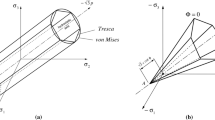Abstract
The constitutive relations and plastic flow rule are derived from the thermodynamics equations. The known procedures of determining the plastic strain rate value are described. A calculation algorithm is presented that is based on the incremental loading, linearization of the virtual power equation and the projection method. A numerical example is presented.
Similar content being viewed by others
References
Levitas, V.I., Bol’shie uprugoplasticheskie deformatsii materialov pri vysokom davlenii (Large Elastoplastic Strains of Materials under High Pressure), Kiev: Naukova Dumka, 1987.
Pozdeev, A.A., Trusov, P.V., and Nyashin, Yu.I., Bol’shie uprugoplasticheskie deformatsii: teoriya, algoritm, prilozheniya (Large Elastoplastic Strains: Theory, Algorithm, Applications), Moscow: Nauka, 1986.
Auricchio, F. and Taylor, R.L., A Return-Map Algorithm for General Associative Isotropic Elasto-Plastic Materials in Large Deformation Regimes, International Journal of Plasticity, 1999, vol. 15, no. 12, pp. 1359–1378.
Ibrahimbegovic, A. and Gharzeddine, F., Finite Deformation Plasticity in Principal Axes: From a Manifold to the Euclidean Setting, Computer Methods in Applied Mechanics and Engineering, 1999, vol. 171, nos. 3–4, pp. 341–369.
Ibrahimbegovic, A. and Chorfi, L. Covariant Principal Axis Formulation of Associated Coupled Thermoplasticity at Finite Strains and its Numerical Implementation, International Journal of Solids and Structures, 2002, vol. 39, no. 2, pp. 499–528.
Simo, J.C. and Meschke, G., A New Class of Algorithms for Classical Plasticity Extended to Finite Strains. Application to Geomaterials, Computational Mechanics, 1993, vol. 11, no. 4, pp. 253–278.
Miehe, C., A Theory of Large-Strain Isotropic Thermoplasticity Based on Metric Transformation Tensors, Archive of Applied Mechanics, 1995, vol. 66, nos. 1–2, pp. 45–64.
Rouainia, M. and Wood, D.M., Computational Aspects in Finite Strain Plasticity Analysis of Geotechnical Materials, Mechanics Research Communications, 2006, vol. 33, no. 2, pp. 123–133.
Simo, J.C. and Ortiz, M., A Unified Approach to Finite Deformation Elastoplastic Analysis Based on the Use of Hyperelastic Constitutive Equations, Computer Methods in Applied Mechanics and Engineering, 1985 vol. 49, no. 2, pp. 221–245.
Eterovic A.L., Bathe K.-J. A Hyperelastic-Based Large Strain Elasto-Plastic Constitutive Formulation with Combined Isotropic-Kinematic Hardening Using the Logarithmic Stress and Strain Measures, International Journal for Numerical Methods in Engineering, 1990, vol. 30, no. 6, pp. 1099–1114.
Lin, R.C. and Brocks, W., On a Finite Strain Viscoplastic Theory Based on a New Internal Dissipation Inequality, International Journal of Plasticity, 2004, vol. 20, no. 7, pp. 1281–1311.
Har, J., A Unified Stress Update Algorithm for Explicit Transient Shell Dynamics with Combined Isotropic-Kinematic Hardening in Eulerian Rate-Type Phenomenological Finite Elasto-Plasticity Models, Computer Methods in Applied Mechanics and Engineering, 2007, vol. 196, nos. 33/34, pp. 3248–3275.
Kukudzhanov, V.N., Decomposition Method for Elastoplastic Equations, Izv.RAN. Mekhanika Tverdogo Tela, 2004, vol. 39, no. 1, pp. 98–108 [Mechanics of Solids (Engl.Transl.), vol. 39, no. 1, pp. 73–80].
Kukudzhanov, V.N., Levitin, A.L., and Sinyuk, V.L., A Numerical Analytical Splitting Method for Modelling Quasistatic Deformation Processes of Damaging Materials, Problemy Prochnosti i Plastichnosti, 2006, issue 68, pp. 7–21.
Arif, A.F.M., Pervez, T., and Mughal, M.P., Performance of a Finite Element Procedure for Hyperelastic-Viscoplastic Large Deformation Problems, Finite Elements in Analysis and Design, 2000, vol. 34, no. 1, pp. 89–112.
Golovanov, A.I., Finite Element Analysis of Large Deformations in Principal Axes, Vychislitel’naya Mekhanika Sploshnykh Sred, 2009, vol. 2, no. 1, pp. 19–37.
Golovanov, A.I. and Sultanov, L.U., Large Visco-Elasto-Plastic Deformation of Solids, Uchen. Zap. Kazan. Gos. Univ., Ser. Fiz.-Mat. Nauki, 2005, vol. 147, no. 3, pp. 75–89.
Golovanov, A.I. and Sultanov, L.U., Numerical Investigation of Large Elastoplastic Strains of Three-Dimensional Bodies, Prikladnaya Mekhanika, 2005, vol. 41, no. 6, pp. 36–43 [International Applied Mechanics (Engl.Transl.], vol. 41, no. 6, pp. 614–620].
Author information
Authors and Affiliations
Additional information
Original Russian Text © A.I. Golovanov, 2010, published in Izvestiya VUZ. Aviatsionnaya Tekhnika, 2010, No. 3, pp. 3–6.
Golovanov A.I., Numerical Modeling of Large Elastoplastic Strains in Terms of Principal Stretches. I. Kinematics of Elastoplastic Strains, Izv. Vuz. Av. Tekhnika. 2010, vol. 53, no. 2, pp. 30–33 [Russian Aeronautics (Engl.Transl.), vol 53, no. 2, pp. 161–166].
About this article
Cite this article
Golovanov, A.I. Numerical modeling of large elastoplastic strains in terms of principal stretches. II. Physical relations, calculation algorithm. Russ. Aeronaut. 53, 243–249 (2010). https://doi.org/10.3103/S1068799810030013
Received:
Published:
Issue Date:
DOI: https://doi.org/10.3103/S1068799810030013



